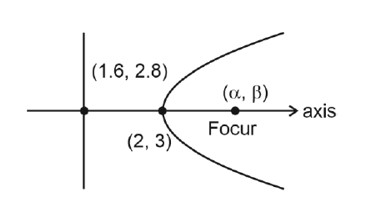Let O be the origin. Let OP = xi + yj - k and OQ = -i + 2j + 3xk, x, y ∈ R, x > 0, be such that |PQ| = √20 and the vector OP is perpendicular to OQ. If OR = 3i + zj - 7k, z ∈ R, is coplanar with OP and OQ, then the value of x² + y² + z² is equal to:
Let O be the origin. Let OP = xi + yj - k and OQ = -i + 2j + 3xk, x, y ∈ R, x > 0, be such that |PQ| = √20 and the vector OP is perpendicular to OQ. If OR = 3i + zj - 7k, z ∈ R, is coplanar with OP and OQ, then the value of x² + y² + z² is equal to:
Option 1 -
9
Option 2 -
2
Option 3 -
7
Option 4 -
1
-
1 Answer
-
Correct Option - 1
Detailed Solution:- Given vectors OP = xi + yj - k and OQ = -i + 2j + 3xk.
- PQ = OQ - OP = (-1 - x)i + (2 - y)j + (3x + 1)k
- Given |PQ| = √20, so |PQ|² = 20.
(-1 - x)² + (2 - y)² + (3x + 1)² = 20
(1 + x)² + (2 - y)² + (3x + 1)² = 20 .(i) - Given OP ⊥ OQ, so OP · OQ = 0.
(x)(-1) + (y)(2) + (-1)(3x) = 0
-x + 2y - 3x = 0 ⇒ -4x + 2y = 0 ⇒ y = 2x .(ii)
Substitute (ii) into (i):
(1 + x)² + (2 - 2x)² + (3x + 1)² = 20
1 + 2x + x² + 4 - 8x + 4x² + 9x² + 6x + 1 = 20
14x² = 14 ⇒ x² = 1 ⇒ x = ±1.
When x = 1, y = 2. When x = -1, y = -2.
So, (x, y) can be (1, 2) or (-- Given OP ⊥ OQ, so OP · OQ = 0.
...more
Similar Questions for you
ae = 2b
Or 4 (1 – e2) = e2
4 = 5e2 ->
If two circles intersect at two distinct points
->|r1 – r2| < C1C2 < r1 + r2
| r – 2| < < r + 2
|r – 2| < 5 and r + 2 > 5
–5 < r 2 < 5 r > 3 … (2)
–3 < r < 7 (1)
From (1) and (2)
3 < r < 7
x2 – y2 cosec2q = 5
x2 cosec2q + y2 = 5
and
->
1 + sin2q = 7 – 7 sin2q
->8sin2q = 6
->
->

Slope of axis =
⇒ 2y – 6 = x – 2
⇒ 2y – x – 4 = 0
2x + y – 6 = 0
4x + 2y – 12 = 0
α + 1.6 = 4 ⇒ α = 2.4
β + 2.8 = 6 ⇒ β = 3.2
Ellipse passes through (2.4, 3.2)
⇒
&
Taking an Exam? Selecting a College?
Get authentic answers from experts, students and alumni that you won't find anywhere else
Sign Up on ShikshaOn Shiksha, get access to
- 65k Colleges
- 1.2k Exams
- 679k Reviews
- 1800k Answers
